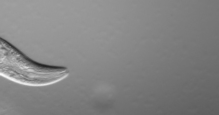Spaceflight is tough on humans, due to weightlessness and radiation exposure. But if it bothers the nematode worm, Caenorhabditis elegans, they aren't talking.
Researchers writing in Nature Scientific Reports say they were interested in seeing how C. elegans reacts to living in space because it was the first multicellular life form to have its full genetic structure mapped. They found the astronaut worms showed less toxic proteins in their muscles than if they had stayed on Earth. Further investigation revealed that seven genes were less active in space; living on the Space Station led to certain genes not functioning normally.
That's bad, right? Actually, they did better. So the researchers turned off the same genes in a laboratory and found that worms raised without the seven genes also lived longer and healthier. Nathaniel Szewczyk says, “Muscle tends to shrink in space. The results from this study suggest that muscles are adapting rather than reacting involuntarily to space conditions. Counterintuitively, muscles in space may age better than on Earth. It may also be that spaceflight slows the process of ageing.”

The transparent nematode worm is about 1 mm in length and lives in temperate soil but research shows that it adapts very well to space conditions. Credits: Creative Commons Share Alike license–B. Goldstein
Humans only share about 55% of genes with C. elegans, so don't get too excited about being better off in space but the obvious next step was to probe human muscle response to spaceflight. Enter André Kuipers, who first went to the International Space Station in 2004 and took nematode worms with him. He did that in the 2012 mission as well, but this time he was also part of the experiment. Before the start of his mission, a small piece of muscle was removed from his leg and kept for analysis. After six months in space, they will compare how his muscles have reacted to spaceflight.
Not right away. Scientists are giving Kuipers a few weeks to recuperate before putting his muscles under the microscope. The worms are not so lucky.


